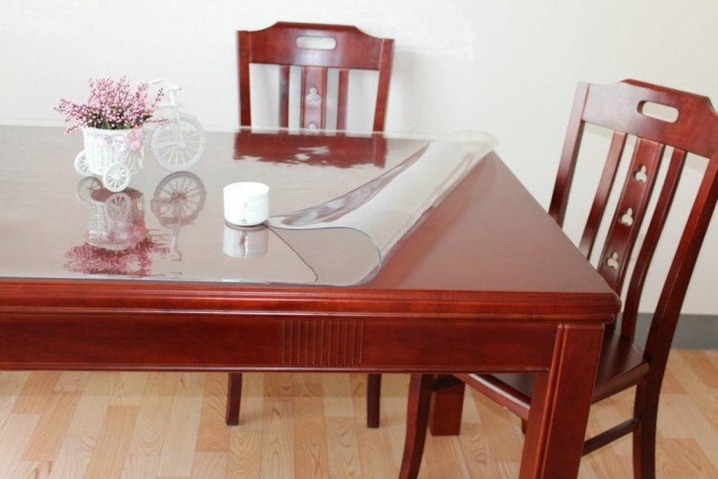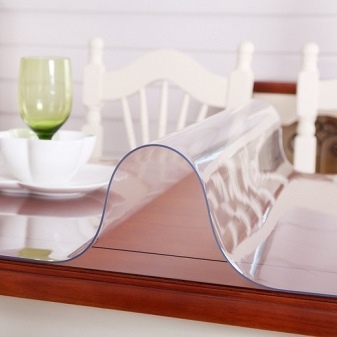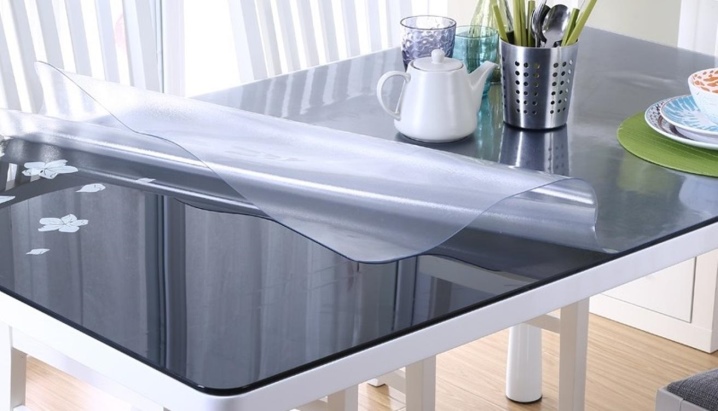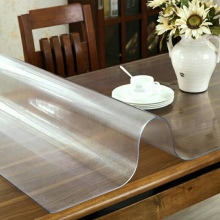Choosing a film on the table

Until recently, the film on the table was associated with Soviet-style oilcloths - hard and not too presentable in appearance. Its modern versions look completely different. Transparent protective silicone and thick PVC films, "liquid glass" for kitchen countertops and other types of such coatings allow you to maintain a fragile, unstable surface.

Peculiarities
Protective foils for tables have gained particular popularity since open furniture designs became fashionable.... On a transparent glass module or a polished bar, smooth ceramics, even cups leave noticeable marks, not to mention scratches that easily appear on such surfaces. In order not to sacrifice aesthetics, in the countries of Asia, where such coatings are especially popular, they came up with special inconspicuous overlays to protect against damage.
They can replace the tablecloth with a decorative cover. But much more often completely transparent options are used, suitable for both a desk and glass in the dining room, living room. In most countries of the world, overlays on the tabletop are called cribs. They are glossy and matte, have different shapes and thicknesses, and fully protect the surface from possible mechanical or thermal damage.


Today on sale the film on the table is most often presented under the name "liquid glass". We list all the properties of this material.
- Stealth... The overlay does not overlap the surface of the table if you want to preserve the texture and pattern of its surface.
- Protective functions... The coating prevents fading under the influence of ultraviolet radiation (the film itself does not turn yellow due to the addition of blue pigment). In addition, it protects against the penetration of active dyes, moisture and chemicals into the structure of the material.
- Heat resistance... There are no traces of hot plates, cups or other dishes on the table. You can fearlessly put a kettle, a saucepan.
- Versatility... In the kitchen, such a film can be used to protect the work surfaces, in the office - the desk. The coating is indispensable for transparent, polished, lacquered smooth materials that easily lose their appearance. When laying on a chipboard slab, it is possible to reduce the risks of moisture penetration into the seams.
- Functionality... Under the film on the desktop, you can store important notes, phone numbers on stickers. If you want to decorate the interior in an original way, you can make a collage of photos on the countertop, and then cover it with protective "liquid glass".
- Ease of cleaning... It is enough to wipe the material with a damp sponge or cloth - no need to use aggressive chemical agents for cleaning.
- The tightness of the fit. On smooth surfaces, the material always lies tightly, without shifting. But if you lay such a coating on an ordinary polished wood, other rough materials, the contact ability will be noticeably reduced.



For the production of such coatings are used hypoallergenic materials (silicone, PVC), ensuring complete safety during use... The film is easily rolled into a roll during storage or transportation, it is not afraid of cracks and creases.
It also has its drawbacks. For example, low resistance to sharp objects, sources of open fire.Lay the film carefully, avoiding the appearance of air bubbles.



Species overview
Once upon a time, table-top boxes were made of genuine leather; today, more high-tech materials are used for this. All existing options are worth considering in more detail.

PVC
Classic film or oilcloth, cut to fit the table. Large items can be stacked on top of a textile tablecloth, protecting it from dirt and damage. This option not too strong, but easy to lay and cut, fits well to the specified dimensional and geometric characteristics.
Films are thinner than other options (silicone or "liquid glass"), often decorated with patterns or color prints, the most diverse in design and texture.



Soft glass
This is not a liquid coating, but a kind of overlays, characterized by significant thickness and tight adhesion to the surface of smooth materials. "Soft glass" is suitable for mosaic, laminated, glass, wood polished surfaces. Such linings are made of transparent PVC, initially the production was established in South Korea. A distinctive feature of such films is surface lamination, which gives it shine and strength. The coating has high flexibility and elasticity, does not lend itself to cutting with a knife and other tools, and is produced immediately molded for certain sizes and configurations of tables.
The characteristics of "soft glass" are as follows:
- the degree of transparency is 98%;
- hardness - 37;
- high resistance to UV radiation;
- food standard compliance;
- safety - there are no heavy metals, hazardous chemical impurities in the composition;
- heat resistance in the range from -20 to +80 degrees.



By their size, films of this type are thick - 2.2 mm, used to protect writing, working, laboratory tables. Averages have an indicator 1.8 mm, can be used on school desks, in rooms for children's creativity, in the kitchen space. The thinnest film - 1.2 mm, suitable for protecting surfaces with minimal mechanical stress: window sills, chests of drawers, children's tables for feeding.
During operation, the material can shrink, lose transparency.



Hard pads
Such a film visually resembles glass or plexiglass. - it is thick, inflexible, and serves to permanently protect the most vulnerable surfaces. Variants of this type are considered commercial and are produced for offices, classrooms, canteens and other catering establishments. If hygienic requirements are met, they can be used in the kitchen. For manufacturing, a special material is used - monocarbonate, which retains transparency for a long time.
Rigid linings have other properties: they are durable, not afraid of direct blows, mechanical cleaning, contact with knives and sharp objects. High temperature resistance enables them to come into contact with hot objects.
This coating can protect kitchen worktops made of chipboard or soft plastic.



Silicone
Products made from hygienic and flexible silicone are in demand in many areas of activity. Opaque and transparent linings from it are used for soldering, working with chemicals and heating devices, they protect tables in medical laboratories. In everyday life, silicone products with a colorless structure are most often used.
Ideal for glass and other designer tables, they increase their durability - the material softens shock loads that can damage a fragile base. Silicone combines well with plastic and stone finishes, lamination, makes such materials more comfortable to use with tactile contact, and reduces slipping.
Silicone pads are not only transparent. Modern manufacturers offer a wide range of such products in color, including those with original prints. In addition, special protective elements for the corners are made of silicone, which soften the blows, which serve as a booster if there are small children in the house.
This material is environmentally friendly, resistant to tearing and other damage, withstands significant operational loads, heat and stretching.



Among the features of silicone films for tables are:
- hygiene, ease of cleaning;
- practicality in use;
- versatility;
- elasticity;
- tightness to surfaces with different structures;
- noiselessness - there are no creaks and rustling when moving objects;
- chemical resistance;
- no sliding effect.
All these characteristics make the material popular. But most of the overlays are small.
Large-format silicone films for kitchen and dining tables are significantly more expensive than PVC products.



Self-adhesive
Opaque permanent countertops are noticeably different from other varieties. They have a thin lamination film on top and a print applied under it either by printing or in the form of a substrate. The lower part is covered with a protective pad made of waxed paper, under which there is an adhesive layer that secures the product on the table. These linings are considered permanent and are difficult to remove after use.
Rather, they perform a decorative function, requiring careful alignment of the base and careful gluing.



Shapes and sizes
There are several types of overlays in shape. Most often these are standard products or options in rolls that you can cut out yourself, removing the excess.
- Round... For tables in cafes, as well as interior coffee and magazine options. The size range varies from 60 to 130 cm in diameter.
- Oval... For non-standard dining tables. The parameters are calculated for the widest and longest parts, you can purchase a product of a slightly larger format, and then trim it.
- Square... Compact products for study desks and office desks. They are often reduced in size and are used on a temporary basis. Popular sizes: 45 × 45 cm, 60 × 60 cm, 70 × 70 cm.
- Rectangular... The most common ones are used to protect kitchen and dining tables, window sills, and work surfaces. Sizes are standardized - most often they are 70 × 120, 70 × 130, 70 × 140 cm, but there are other options.
These are the main shapes and sizes of modern table films.



Design
The color scheme and decorative design of films for tables, regardless of the material of their manufacture, are very diverse. The most popular is the transparent protective film, which is practical and easy to use. It is versatile, well suited for tables with a pronounced texture of stone, wood or ornament. In this case, the beauty of the material will be preserved, and the surface is protected from damage.
This property is also valuable for office worktops - you can place instructions for staff or important notes for the exchange of information between employees under the film.


Other types of decorative overlays are also popular.
- Patterned... It is a transparent film with monochrome graphic patterns. Such products have great expressiveness and visual appeal; they look good on kitchen tables with monochromatic lamination or plastic as a finish.
- Matte... They are transparent and colored, and often have a pronounced granular structure. Such materials have their advantages and disadvantages. For example, a colored silicone pad will be useful for protecting the surface when a child is working with crafts, paints, a fabric or wood burner. Lightweight PVC films of this type will hide minor surface imperfections on an old kitchen or worktop.
- With prints... Such films are considered decorative, they can contain almost any image: from romantic landscapes to cups of coffee. For school-age children, you can find overlays with formulas, examples, maps, or other useful prints.
- Transparent colored... Suitable for interior decoration and for organizing creative work. The films look bright, are lightweight, and can be easily removed for storage if necessary. You can find both glossy and grainy varieties.
These are the main designs used in making table films.



Top manufacturers
Films of the "liquid glass" type are produced by many well-known manufacturers. Among them DeVetro - its products belong to the premium class, are famous for their strength and durability, they are the most resistant to mechanical damage. Products Siliconica less durable, difficult to maintain, not too resistant to mechanical damage. Decosave - "liquid glass" for decorative purposes, despite its rather high thickness, the film is oriented, rather, for office use.
Among the manufacturers of PVC and silicone products, recognized leaders are IKEA, Mevia, Ofiston, Modern. Each of these firms has its own lines of products for home and office; updated collections are regularly released.



You can learn how to paste over a laminated chipboard table with a film from the video below.













The comment was sent successfully.